Meet the Brothers Who Think They Can Fix Northern Liberties
Bart Blatstein built it. Jared Kushner bungled it. Do the Post Brothers have the answer for Philly’s most puzzling neighborhood?
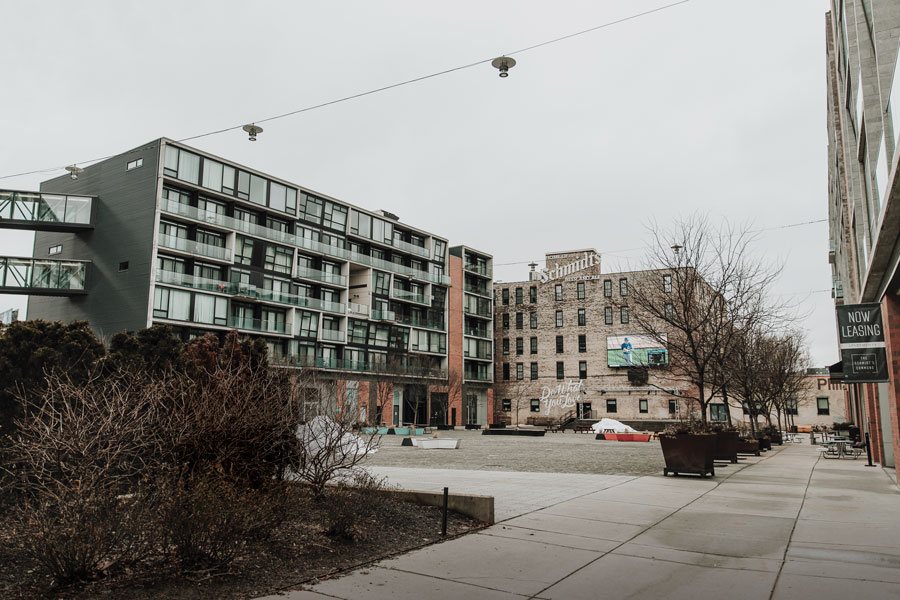
The Piazza at Schmidt’s in Northern Liberties. Photograph by Adam Englehart
You could start a story about Northern Liberties 100 different ways.
You could start with Bart Blatstein, the first mega-developer to take a chance on the blighted, bombed-out neighborhood, in the early 2000s. You could start with Will Reed and Paul Kimport, who opened Standard Tap in the late ’90s, back when its only neighbors were a couple of chicken-processing plants and a shifty brake-relining joint. You could start with Ira Upin, one of the artists who came to the neighborhood in the ’70s in search of cheap studio space, or with the Bell family, who came here at the cusp of the 20th century in search of opportunity, eventually finding it in a flooring shop that’s one of the oldest businesses in Northern Liberties. But I’ll start with Mike Pestronk, because as the CEO of Post Brothers, he’s now leading the charge to redevelop the massive Piazza complex; because his plans could very well redirect the trajectory of the neighborhood; and because, well, he’s standing right next to me.
It’s a bitter January morning, the sort of day where the sky looks as though it’s been smudged away by a giant eraser. I’m standing on a deserted stretch of Germantown Avenue, a snippet of street between 2nd and Hancock, staring at what Pestronk sees as the future of Northern Liberties, or at least part of it. I squint and pretend that I see it, too. In reality, here’s what I see: a parking garage, the back of an Acme, a gray crest of I-95, a dirty fence, a potholed street and an empty lot. The whole thing looks rather post-apocalyptic, but I don’t tell Pestronk this. I’d rather get inside before I politely ask him how the hell he plans to transform this empty wasteland into a destination.
Of course, Post Brothers — a real estate development firm started by actual brothers Mike and Matt Pestronk, who, while not born here, went to Drexel and then never left — aren’t the first to attempt this rubble-to-rebirth transformation in Northern Liberties. The efforts of their predecessors loom large behind us in the form of the Piazza at Schmidt’s, Blatstein’s three-acre mixed-use complex that opened a decade ago in a blaze of glory and then flamed out just as spectacularly.
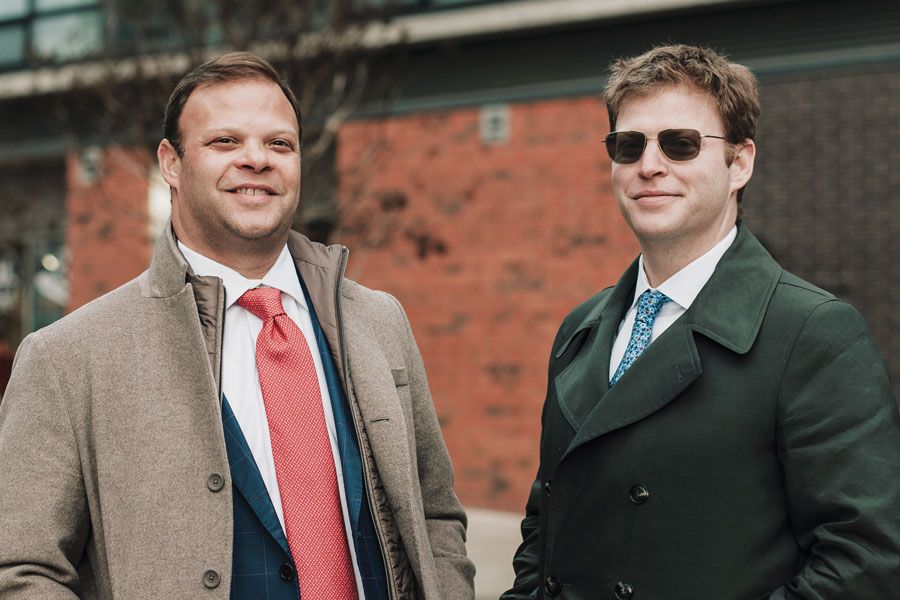
The Pestronk brothers, Matt and Mike, in the Piazza, which they now own. Photograph by Adam Englehart
The Piazza, a concrete grid of residential apartments, ground-floor retail, and a vast public plaza, was once a wasteland, too, part of the larger 14-acre Schmidt’s Brewery property that Blatstein scored at a sheriff’s sale in 2000 for $1.8 million. But emptiness often means promise, and Blatstein’s plans for the Piazza were full of it: inviting public space, cool local businesses, a hub of activity and community, European flair, all in one! In fact, when he bought the property, the whole neighborhood was promise, a largely forgotten post-industrial playground of empty factories and vacant lots with a few pinpricks of life.
“It was like a tinderbox ready to go,” says Will Reed, who opened Standard Tap on one of the last days of 1999. He ticks off businesses that opened around the same time, each propelling more development, like dominoes: the 700, Rustica, North 3rd. The neighborhood started to change the way most neighborhoods do, through small-scale, organic growth — one cool business comes, followed by another and then another. But then, Reed says, “the Piazza happened.”
If Northern Liberties was a tinderbox, the Piazza was a $100 million match. The long-overlooked neighborhood was suddenly linked to descriptors like “hottest,” “up-and-coming,” “hippest,” “next” and “best.”
But while the Piazza catapulted the area to a new level of success, today it’s one of the factors holding NoLibs back. Twenty years after Blatstein staked his claim, this is still a neighborhood in flux. On paper, it’s a success story, but in public opinion, it’s more of a head-scratcher. (“Yeah, what’s going on over there?” nearly everybody said when told I was writing this story.)
You can blame this on a lot of things. On Blatstein, who realized his fever dream of an Italian piazza in Philadelphia, for God’s sake, only to shift his focus a few years later to other goals, like casinos and rooftop villages. On Jared Kushner (yes, that Jared Kushner), whose real estate company took over the Piazza in 2013 and by some accounts mismanaged it into oblivion. On a spate of bad Piazza press, including three murders and one rather unfortunate incident of public sex. You can blame the neighborhood’s challenging location, hemmed in by a river and highway, or the poor design of its business corridor, or the dismal state of retail. But whatever the reason, Northern Liberties remains the land of unrealized promise. “I feel like it’s still at the up-and-coming stage,” says Megan Brewster, a co-owner of Art Star, an artsy gift boutique that’s one of Northern Liberties’ marquee businesses. “It never really came.”
Some people will disagree with this, including Matt Ruben, the longtime president of the Northern Liberties Neighbors Association (NLNA) and the neighborhood’s resident historian. He insists that Northern Liberties did make it; just look at Liberty Lands Park and events like the popular 2nd Street Festival. More importantly, there are the numbers. The residential population has more than doubled since 2000, as has the average household income, which is now the third highest in the city; the median home-sale price soared from $42,500 to $323,000.
“Northern Liberties has a supermarket and pet places and personal-care places and a French bakery and restaurants and new bars and record stores, and people just don’t know about them,” Ruben says, exasperated. “And people don’t know about them because the obsessive focus on loving and hating the Piazza blotted out the sun for a decade.”
But maybe that’s about to shift. This year, Post Brothers will begin an overhaul of the Piazza, which it purchased from Kushner in 2017, while Blatstein will break ground, after two decades, on the final piece of his neighborhood dream project: Piazza Terminal, a giant $400 million apartment and retail complex just north of his original Piazza. But can the eternally up-and-coming neighborhood come … again?
A few days after my meeting with Pestronk, I walk through Northern Liberties, taking in the million-dollar townhouses butting up against vacant lots. I end up in the Piazza. It’s another cold, gray day in a string of cold, gray days, so I can’t blame everyone for being anywhere but here, yet the courtyard feels embarrassingly barren. Making matters worse is the 40-foot LED television mounted on the plaza’s southern wall, airing a college basketball game to no one.
“We’re sort of trying to revitalize a vibe,” says Ira Upin, the artist. “And … we’ll see.”
Bart Blatstein wants to make sure I got his text.
“I’m going to send you a photo,” he says a few minutes into our phone conversation. “Okay, I sent you the picture.” A few minutes later: “Did you get it? See if you got it.”
I check my texts, and there it is: a side-by-side before-and-after photo comparison of the Piazza. On the left is the property in 2005. In the picture, Blatstein is perched in a foldable camping chair in the empty dirt lot, grinning and flashing a thumbs-up. Sitting next to him is Tommy Updegrove, known to most as Tommy Up, Philly’s party-boy entrepreneur who helped fuel the Piazza’s frat-house reputation with his now-defunct boozy burger joint, PYT. And on the right, leaning coolly against a pickup truck, is fellow developer Roland Kassis, who, while Blatstein was busy building Northern Liberties, was himself busy whipping Fishtown into the Next Big Thing.
The photo on the right was taken five years later from the same angle, only instead of mounds of dirt, three handsomely designed glass-and-concrete apartment buildings rise up around an enormous central plaza. You can’t actually see the plaza, though, only a mass of people — thousands of them squished sardine-like into the 80,000-square-foot space. A band plays on a giant stage, and apartment residents cluster on their balconies to take it all in.
“Look at the image I just sent you. Are you looking at it?” Blatstein says.
Unbelievable, I tell him. The transformation is, truly, unbelievable.
“This is not a controversial story,” he tells me. “This is a happy, oh my God look what happened here story. It went from nothing to where it is today. We were the catalyst for change.”
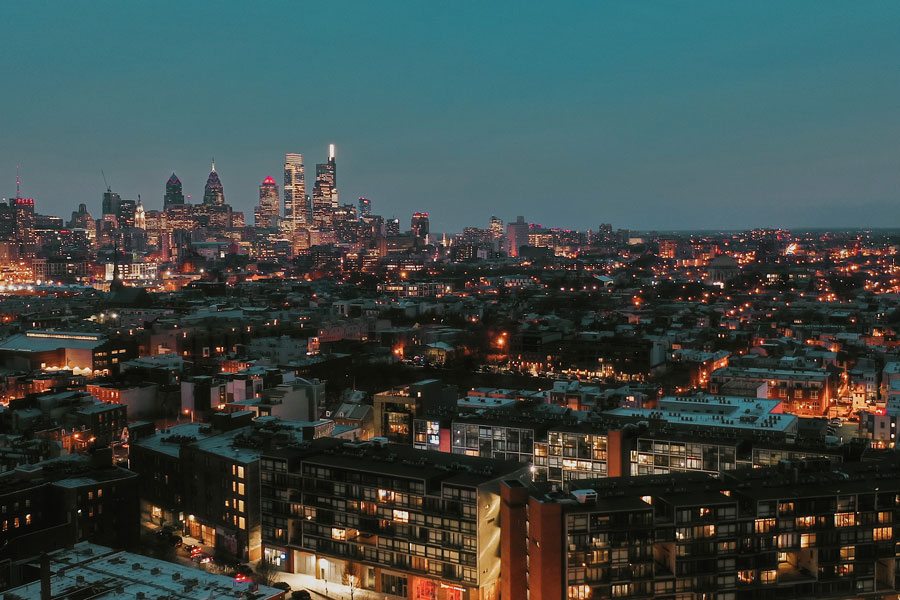
Overlooking the Piazza at Schmidt’s at night. Photograph by Adam Englehart
Yes, in a story about Northern Liberties, the main character is the Piazza. “The Piazza is so large in such a small, contained neighborhood — it just takes up such a large footprint of the space — that the neighborhood could live or die by what happens there,” says Up. Which means that Blatstein is either the story’s hero … or its resident villain. But back on August 6, 2011, at the very height of the Piazza’s success, he was more like an uptight dad.
Blatstein remembers it like this: He’d agreed to let the annual Mad Decent Block Party, basically a giant outdoor rave, take place at the Piazza. Diplo would be spinning at the free all-ages concert, along with 10 or so other EDM artists. (“Diplo? I never heard of Diplo — who the heck is Diplo?” Blatstein recalls thinking.) He was at the Shore that weekend and called Up to ask how things were going. The update was this: Diplo was a hugely popular DJ and producer, and around 8,000 kids had shown up. Blatstein hopped in the car and sped to Philly.
“It was like your parents went out of town and you had this party that just escalated — you know, couches-out-on-the-lawn type of thing — and your parents come home,” says Up. He wove Blatstein through the party, through throngs of drunk kids clutching cans of PBR, their bodies streaked with Day-Glo body paint as they doused each other with neon water guns. “He lost his mind.”
Sure, a rave wasn’t exactly what Blatstein had envisioned — he’d modeled the Piazza after the grand Piazza Navona in Rome — but it was undeniable: Bart Blatstein had pulled it off. The Piazza at Schmidt’s was the success story no one saw coming. After all, before the Piazza, Blatstein was best known for his uninspired strip-mall developments, like Delaware Avenue’s stretch of big-box stores and Manayunk’s movie theater. Will Reed remembers it: “He just bought this gigantic property, and we’re like, oh fuck. Yeah, nobody wants it to stay a big, hulking abandoned building, but this is pretty scary. What’s he going to do? And all the first plans were strip malls with an acre of parking.”
But Blatstein had abandoned his Kmart plans (yes, Kmart) and instead pacified the neighborhood with a thoughtful use of vacant land. He’d ditched cheesy “Disneyesque” design (Roman columns and other Italianate kitsch) for refined modern architecture by renowned firm Erdy McHenry. He’d captured the attention — and the rent dollars — of a young, upwardly mobile demographic, and he’d created a scene cool enough to attract thousands of 20-somethings to what was essentially the courtyard of an apartment building. Even sharp-penned Inquirer architecture critic Inga Saffron praised the project in her 2009 review: “The Piazza accomplishes something rarely seen in new American developments: It feels like a real place.”
But success cuts both ways. “Northern Liberties really isn’t that big, so with some hype in the neighborhood, the amount of developable real estate that was in play went to zero so fast,” says Reed. Developers combed the area, property values skyrocketed, and entrepreneurs looking for an affordable way in had to go elsewhere. Case in point: Reed and Kimport opened their second venture, Johnny Brenda’s, in Fishtown.
This Northern Liberties is a far cry from its beginnings in 1682, when lots here were given away to anyone who purchased land in Philadelphia proper. (Buy one, get one free!) By the mid-19th century, the population had swelled to 17,000, and Northern Liberties had become an industrial hub, its landscape blanketed by sprawling factories, tanneries, mills and breweries. But most of those businesses had either closed up or moved on by the mid-20th century, leaving the neighborhood riddled with deserted industrial buildings, its population whittled down to about 3,000. From there, development happened in fits and starts: a brief surge in the ’80s, another dip in the ’90s, the beginnings of organic growth toward 2000, and then — well, then Bart Blatstein. (Although there weren’t a ton of people to be displaced here, development on post-industrial lots created a new housing market, which shifted the population from a mid-20th-century working-class melting pot to an exceedingly white, high-income demographic.)
Blatstein approached Northern Liberties like his personal Monopoly board, accumulating more than 100 parcels of land — most blighted, abandoned lots — in the course of four years, at one point effectively owning some 15 percent of the entire neighborhood. “It was the Wild West here,” says NLNA’s Ruben. “And Blatstein owned so much of the neighborhood at the time. … I don’t know if there’s been another neighborhood where one person has had such a decisive and fundamental impact, for better or for worse.”
He’s right: Plenty of neighborhoods have had to deal with recessions and depopulation, but far fewer — if any — have had to contend with a 14-acre albatross like Schmidt’s. And while neighborhoods like Fishtown were poised for an organic rebirth — with the framework of housing stock, commercial corridor, and stable residential base already in place — Northern Liberties was mostly a blank slate. So while it’s unfair to compare Fishtown to Northern Liberties, it’s also impossible not to, since the neighborhoods dissolve into one another and exploded in rapid succession.
Today, both areas have the trappings of success — couples pushing pricey strollers, dog parks, bustling coffee shops, sidewalks bulging with construction — but there’s a sizzle of energy in Fishtown that Northern Liberties lacks, one that comes from having places like super-cafe Suraya, Philly’s current crown jewel, in your backyard.
“There are a couple of ‘forever’ establishments in Northern Liberties, like Standard Tap and One Shot Coffee, but it feels like there have been minimal places that have stuck enough to make Northern Liberties a destination,” says Shannon Craige, a 36-year-old who moved from Northern Liberties to Fishtown several years ago.
Both areas have the trappings of success — couples pushing expensive strollers, dog parks, bustling coffee shops, sidewalks bulging with construction — but there’s a sizzle of energy in Fishtown that Northern Liberties lacks.
This revolving door is most evident in the Piazza. Of its original 37 commercial businesses, only one remains: Creep Records. (The same cycle played out at Blatstein’s Liberties Walk, a four-block corridor of walk-ups with first-floor retail that links to the Piazza and was included in Post Brothers’ purchase.) A lot of the problem is structural: Almost all the storefronts face the courtyard, with their backs to public streets — part of Blatstein’s bullish attempt to bend basic tenets of urban design to fit his Euro fantasy. (The Pestronks are turning the storefronts to face the street.) Add to that Blatstein’s well-intentioned but ultimately unsustainable plan to seed the retail space by offering below-market rents to creative independent retailers, and within a few years, most businesses had either closed or fled for better locations. (Some stayed in the neighborhood.) “When you’re around so many places that open and then fail, that sends an energy out to the community,” Craige says. “People want to be where good things are happening.”
Good things like Lululemon Local, which sells goods from local artisans alongside its $100 yoga pants, and the gorgeous La Colombe flagship, and Toile Boutique and Amrita Yoga, all in Fishtown. But almost all of these have one thing in common: They were specifically curated by developer Roland Kassis, the guy leaning on the pickup in the photo Blatstein texted me. Almost everyone I spoke to for this story asked me if I know of the developer and am aware of the magic he’s worked a couple of blocks away. Pestronk goes a step further: “If Roland Kassis had taken over the Piazza and not Kushner, all of that would have happened here.”
But guess what? Roland Kassis — the visionary developer who has a nose for where the next big thing will happen — lives in Northern Liberties.
The giant robot appeared in mid-January, out of nowhere. One day, the lot across from Wahlburgers was empty, and the next day, there it was: a 33-foot-tall, 13,000-pound sculpture of a smiling, waving robot. The gossip began almost immediately. “Does anyone have any ideas what this gigantic hearted metal sculpture thing is in #NorthernLiberties?!” Conrad Benner of the StreetsDept blog wrote on Instagram.
According to Pestronk, that’s just what was supposed to happen. Post Brothers bought the art installation, Bebot — made for last year’s Burning Man festival — to stoke buzz and anchor a temporary shipping-container park, opening this month, in the empty lot wedged behind the parking garage and the Acme. The lot itself belongs to Blatstein and is the future site of his Piazza Terminal development. Until then, he’s renting part of the property to Post Brothers for its pop-up park. (Yup, in an only-in-Philly turn of events, not only is Blatstein the guy who created the apartments the Pestronks are now tearing apart; he’s also their landlord.)
The park is part of Post Brothers’ plan to shift the Piazza’s center of gravity from the central plaza out to the 1,000-foot stretch of Germantown Avenue between 2nd Street and Hancock. They’re creating a “woonerf” here — a hardscaped pedestrian-centric street that discourages, but doesn’t prohibit, car traffic (which is to say, you can technically drive down it, but you’ll feel like a jerk if you do). All of this means that eventually, much of the land between Front and 2nd and Laurel and Girard will be a sort of super-complex — two Piazza developments by two very different developers, linked by that woonerf. (The word’s Dutch.) Pestronk and Blatstein wouldn’t confirm any master plan from the two complexes aside from a vague “sharing ideas,” so all this could end up as an example of smart, cohesive urban design — or a total shitshow.
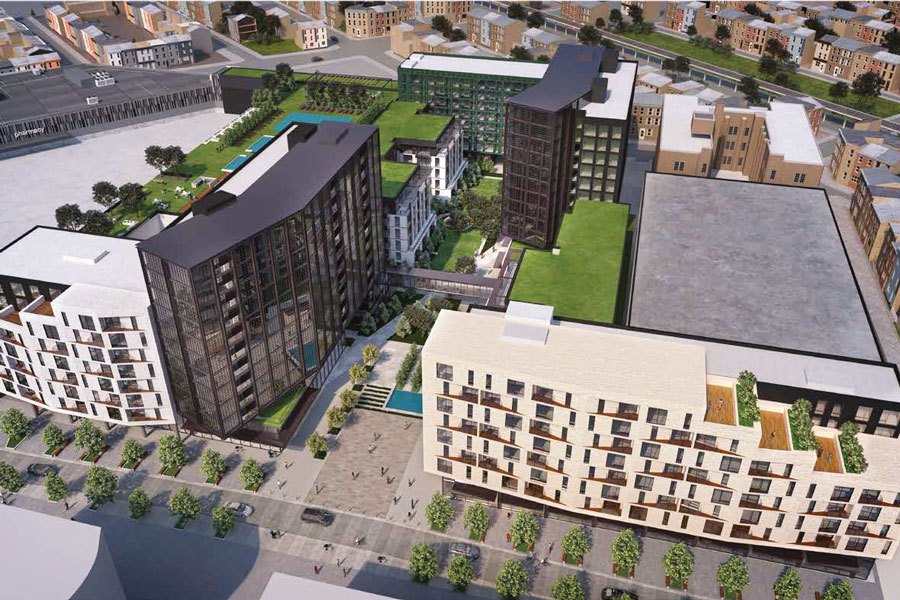
A rendering of Blatstein’s new Piazza Terminal complex. Rendering courtesy Tower Investments, Inc./BKV Group
But it would take even the most successful developers a while to revive the Piazza after its latest round of ownership. Manhattan-based Kushner Companies — in partnership with investment management firm Oaktree Capital — bought the Piazza from Blatstein in 2013 for a reported $130 million, then set about slicking it with New York polish: rebranding it as “the Schmidt’s Commons” (a name that still hasn’t stuck), bringing in deeper-pocketed franchises, and gutting things like ample security at public events. (This last led to the Piazza’s infamous Radio 104.5 concert in 2014, which spiraled out of control and ended with a viral video of a couple having sex in a condo alleyway. “As soon as I saw that, I went, Oh. It’s over. There’s no way to spin that,” Up says. “So that was the last concert they had. Due to two kids getting it on outside of someone’s $800,000 house.” He adds that the Mad Decent Block Party a few years earlier had been crazy but ultimately well-managed.)
Blatstein insists that when Kushner bought his project, it was still at the top of its game: “When I sold the Piazza — and it’s very important you make this clear — the residential was 97 percent occupied, and the commercial was 100 percent. It was full.” Others don’t pin the Piazza’s decline on Kushner, including Inga Saffron, who says, “It was tanking before Kushner bought it.” Regardless of who fueled the decline, Post Brothers got the property for $44.1 million in 2017. It was an $85 million devaluation. In five years.
But the neighborhood had other issues outside of the Piazza, like its gap-tooth commercial development, which is in most cases due to owners and landlords sitting on vacant or underutilized properties like roosting chickens. Claire Ogilvie and Marc-André Basile, owners of bakery and coffee shop Kettle Black, ran into several closed doors as they hunted for commercial space on North 2nd Street: empty buildings, no response. “It’s disappointing, these potential opportunities,” says Ogilvie. “And I don’t think it’s based on lack of interest, because we can’t be the only ones who wanted to get into some of these spots.”
This explains why many folks are pinning their hopes for a commercial renaissance on the neighborhood’s new Business Improvement District, a nonprofit funded by commercial property owners that provides services like capital improvements, cleaning and marketing. “The BID is now really relevant because we’ve been surpassed by what’s going on in the BIDs in Passyunk and then what’s happening on Frankford Avenue in Fishtown,” says Ira Upin. “I think the BID is going to help put us back in competition with some of these other places.”
Walking down the business corridor, North 2nd Street, is sort of like walking into a real-life version of one of Blatstein’s before-and-after photos: Moments of greatness cozy up to emptiness. For every Art Star and Kettle Black, there are at least three spaces plastered with butcher paper. In one storefront — granted, one tucked away in Liberties Walk — a handwritten sign is taped in the window:
We are moving! Join us in the New Year at our new Fishtown location.
Mike Pestronk knows he’s got a lot to contend with. And if all the empty storefronts pockmarking North 2nd underscore the need for a BID — which, now that it’s officially armed with a full-time executive director and a $374,000 budget, can make a huge difference — they also put even more pressure on him.
“I think the $100,000 question is: Where’s the campaign that entices people to see the beauty and value of spending a couple hours walking around Northern Liberties?” says Rick Jackson, who moved to the neighborhood with his family in 2004. “And what’s interesting is, even if you wanted someone to spend a couple of hours in Northern Liberties, the biggest concentration of things to do, businesses to visit, restaurants and bars to go to, it’s all right around the Piazza. So you’re really inviting them to the Piazza, not to Northern Liberties.”
Jackson may be right about the Piazza being the de facto center of commercial life. But the campaign may not be as crucial as he imagines: Northern Liberties has recently become a magnet for medium-size companies that prefer funky office space to Center City’s cubicles in the sky. In fact, Philly’s start-up community could be the catalyst that kick-starts commercial growth.
“All the cool shit has opened up in other places,” says Wil Reynolds, CEO of tech company Seer Interactive, whose offices take up every single floor of the Piazza’s egg-shaped Rialto building. “I’ve got 140-plus people every day coming in and out, and most everything in the Piazza is boarded up. So I have a target demo that would do certain things, go to certain things, see value in certain things, and we don’t stick here. My whole company will have a happy hour over in Fishtown before I have it in the space where we are.”
KieranTimberlake architects, brand-identity firm J2 (which is helping the BID come up with a way to market Northern Liberties), and start-ups Jarvus and Localhost have also set up shop here, funneling hundreds of young, cool creatives to the neighborhood every day. GoPuff, the Philly-born on-demand delivery service, is moving its headquarters to the Finnegan’s Wake building, once a boozy nuisance establishment. (“Whatever happened that made Finnegan’s Wake leave and GoPuff come? Let’s do more of that,” Reed, the BID’s president, joked at a recent BID meeting.) And Blatstein’s Piazza Terminal, with its 1,200 apartments, should plant even more feet on the ground, something sorely needed in Northern Liberties, since its residential blank slate was filled with huge, family-oriented townhouses — great for elbow room, not so great for the density needed to sustain a vibrant commercial district.
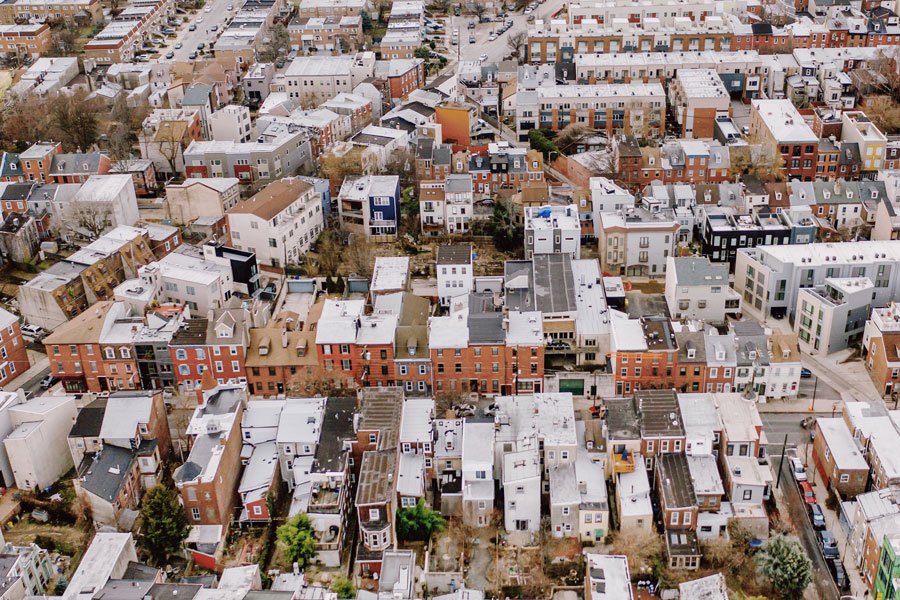
Northern Liberties, from above. Photograph by Adam Englehart
Post Brothers is excellent at revitalizing lackluster apartment buildings and buttressing them with luxe amenities. (Among the projects on its résumé: Germantown’s Rittenhouse Hill and Callowhill’s Goldtex.) These wheels are already in motion: Completed gut-level renovations reveal sleeker, smarter, richer design — a far cry from the original apartments, which one former tenant describes as being “like a movie set, beautifully painted facades held up by cheap two-by-fours.” And residents will soon have a tricked-out amenity complex — pools, a sundeck, a spa — sunk into the middle of the courtyard and set off by a glass railing. But the Piazza project has huge swaths of commercial space to fill — 125,000 square feet — and Post Brothers’ retail chops aren’t as well-tested. The Pestronks hope more local retail will return and have already evicted some soulless Kushner-era holdovers. Still, redeveloping the Piazza goes beyond amenitizing, renovating and evicting. It’s about figuring out what Northern Liberties 2.0 — no, 3.0 — will look like.
After Mike Pestronk finishes pointing out where the shipping-container park will go, he leads me out of the cold into a makeshift gym his team set up in one of the Piazza’s vacant storefronts. He explains how Blatstein’s future Piazza Terminal development will seamlessly thread the eastern side of the neighborhood together — North 2nd Street up through the Piazza, through the woonerf of Germantown Avenue, up through the Piazza Terminal courtyard (“much more of an entryway plaza, though, not this enormous 80,000-square-foot white elephant,” says Ruben — a sign, he thinks, that Blatstein has learned from his Piazza experience) and into the transit hub on Girard.
In 2013, Bart Blatstein started selling chunks of his Northern Liberties properties: the Piazza first, then the event space Tendenza, then a group of properties on which Streamline development firm is in talks to build another housing complex, and, finally, the building where his company, Tower Investments, was located for 15 years. (He moved his offices to Rittenhouse in 2017.) Blatstein still owns a fair amount of Northern Liberties property, but it’s safe to say he’s no longer the neighborhood’s developer-in-chief. The changing of the guard will officially start this spring, when Post Brothers moves its Bala Cynwyd headquarters to a building just outside the Piazza.
Blatstein was defensive the first time we talked, bristling whenever I used the word “potential.” There was no potential, he explained; his project had obviously already succeeded. “How could I be disappointed?” he said when I asked how he felt about the Piazza’s relative decline. “This grand idea, it worked!”
But he called me back, unprompted, a few days later, and this time, he was softer, more reflective. He allowed that the Piazza had been neglected, that it lagged in recent years and that, yeah, he had stopped focusing on Northern Liberties. It was time, he said, to let somebody else take it from here: “It’s a passing of the baton.”
“It’s a life cycle, and like any life cycle, it’s always morphing and changing,” says Rick Jackson. “There’s almost nowhere left to develop in Northern Liberties. Outside of what’s developing or what is going to be developed, I don’t know where Northern Liberties goes. Then, its growth comes from transformation.”
You could end a story about Northern Liberties 100 different ways. With the Bell family, whose patriarch, Harvey Bell, one of the neighborhood’s pioneers, died while I was reporting this story. With Ira Upin, who used to have to walk for blocks just to find another person living in the neighborhood and who now lives down the street from the Eagles’ Malcolm Jenkins. With the Standard Tap guys, who are trying to figure out where their bar stands now, nearly 20 years after opening. (“We’re not the new kids on the block anymore. Maybe a beloved classic?”) Or with Blatstein and the Pestronks, who are, as you read this, filling empty spaces with promise (and, thank God, not a Kmart). You could end it one thousand ways, except with “The End,” because you never end a magazine story that way, especially not one about Northern Liberties. So I guess it’s this: To be continued.
Published as “What’s the Matter with NoLibs?” in the April 2019 issue of Philadelphia magazine.


